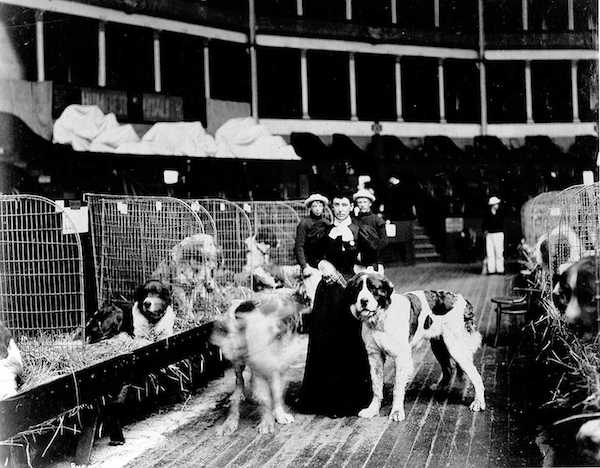
By 1894, the press had taken to calling her “little Miss Whitney,” but there was nothing diminutive about what Anna Whitney did.
If you are a woman or younger lady who shows dogs, judges and/or breeds them, you’ll want to know more about Anna. You’ll also want to give a respectful (if not surprised) nod to the 19th century men of Westminster Kennel Club who did the right thing, though probably not for the right reason.
Anna was of good breeding, as they would say at the time. Her people were entrenched New Englanders having been established by the family patriarch, John Whitney, in the 1600s. Anna was cultured, educated, and like all well bred young women of her day, had done the requisite Grand Tour of Europe. Unlike other females of the time, however, Anna worked. She taught at private and public schools, no doubt enabled, if not spurred on, by her Harvard educated father, Asa. Certainly, this was an anomaly for Victorian times, but blazing new trails would become the norm for Anna. She was the first woman chair of a school board, the first woman secretary and the first woman treasurer of the library committee, and its only female member. As you’ll see, being first at anything wasn’t unusual for Anna.
During her teaching career, Le Roy Collins, a principal from one of the high schools at which Anna taught, offered her the pick bitch out of a litter of Saint Bernards he’d bred, one of the earliest litters in the US. Anna didn’t hesitate for a moment. A avid dog lover, Anna had owned Greyhounds, King Charles Spaniels, Newfoundlands, a few mixed breeds, and even a Mexican Hairless (what we know today as the Xoloitzcuintle) since childhood. The show world beckoned, and with the encouragement of Collins, she became well acquainted with it. She started her Chequasse kennel of Saint Bernards, and hit the shows.
Few of us can appreciated the restrictions of women in Anna’s day. In the eyes of the law, once a woman married, she became one person with her husband, and after they said, “I do,” everything she did was under his direction. Single women or widows were allowed to own their own property and possessions, but as soon as they married, their property and any money they owned transferred to their husband. The few things a married woman could legally own were personal articles, her clothes, and “doo-dads” befitting her rank and circumstances. In a marvelous article by Adrienne A. Pagel, the author cites a lawsuit from 1895 in which a woman sued her husband for having sold without her consent the Cocker Spaniel she’d had since it was a tiny puppy. She lost. The court ruled that her husband legally owned her dog and could sell it.
So one can imagine the stir caused when a gowned women entered a show ring in the late 1800s with an enormous dog. Mind you, women had been entering and attending dog shows for a couple of decades before, but physically going into a show ring? Pass the smelling salts. A few brave souls did it, but it was akin to hiking up one’s skirt and showing some leg while a cigarette dangled from one’s mouth.
Convention didn’t stop Anna, and indeed, she showed her Saints frequently and with vigor. She was offered the position of President of the Saint Bernard Club of America and declined, choosing instead to be its Vice-President. After thirteen years of holding the leash of a dog in a ring, she became a show judge, and her name was put forward as a recommended judge for the AKC. Indeed, Anna was among the first judges to be AKC approved.
When it came time to assign judges for the Westminster Kennel Club Dog Show in 1895, the selection committee of all men recognized a fabulous marketing opportunity when they saw one in the form of Anna Whitney. Her assignment of 117 Saint Bernards at Westminster made Anna the first woman to judge a dog show in America. Wearing dark blue pleated wool skirt and a black velvet bonnet, Anna’s ring was, to say the least, well attended. Every move was watched, what she chose to wear was reviewed, and how she made her selections, scrutinized. In the end, Anna was a huge success both in how she judged, and the number of tickets her presence sold at the gate. Upon completion of her assignment, she was given a bouquet of flowers
Anna judged every year for another seven years, but her success wasn’t contagious. It was 1901 before another woman besides Anna judged a dog show in the U.S., but the dominoes would fall, and Anna helped tip the first one.
Anna judged her last Westminster in 1903 at the age of 58. By then, other women had been emboldened to enter and exhibit their own dogs and the notion was no longer bizarre. She passed at the age of 77 in 1922 at the age of 77, and one newspaper that reported her death wrote, “A brave spirit has left us.”
For all her accomplishments, it was challenging to find anything about Anna Whitney’s life beyond her assignment at Westminster; we are beholding to “Brynn” at the AKC library for unearthing a marvelous article written by Adrienne A. Pagel and published in an issue of the AKC GAZETTE in 1984. We’ve borrowed some factual data from Ms. Pagel’s article and would encourage you to read it in its entirety, but we are still on the hunt for its appearance on-line. The photo of Ms. Whitney with Saint Bernards is from 1897.
